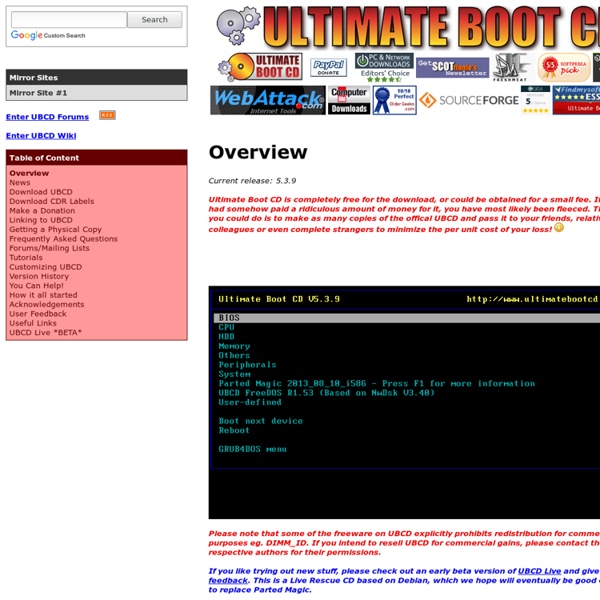



UBCD for Windows Not A Dollarshort Advanced System Optimizer 2009 - TopTenREVIEWS Advanced System Optimizer is one of the best PC system utilities on the market today and our TopTenREVIEWS Gold Award winner. It excels at maintaining the performance of your system by repairing errors in the registry and on your hard drive, protecting your system and privacy, and optimizing sluggish system processes. We appreciate that this application has an easy-to-use interface which is loaded with features that are both user-friendly and extremely functional. If your computer is having problems, Advanced System Optimizer likely has the tool that can fix it. Management/Diagnostics Compare Advanced System Optimizer WinZip System Utilities Suite System Mechanic MAGIX PC Check & Tuning TuneUp Utilities SystemSuite Advanced SystemCare PRO Spotmau PowerSuite Auslogics BoostSpeed WinUtilities Advanced System Optimizer provides many tools to diagnose issues and maintain your computer's performance. Other features of this PC system utility work together to identify and solve security concerns.
How to Reinstall Windows XP Easily This howto will demonstrate how to keep all of your data while reinstalling Windows without copying it off of your hard drive. This will only work if you have a Windows XP CD or a real source to install it from, NOT a manufactures "Restore CD" which reloads all the junk it came with. I have seen people on the internet dread reinstalling Windows because it takes so long to backup gigabytes of data and to restore it later! I have found a way that makes it so you do not have to go through the whole hassle! Read on to find out! This guide will show how to create a Bart PE (Preinstalled Environment) live Windows CD and how to use that CD to make the reinstallation of Windows easier.You will need a Windows XP CD (The I386 directory some manufactures put on the computers in either C:\ or C:\Windows\ Might work) or installation source to be able to use this guide. Press Create ISO image and then press Build. And wait for building to be complete.
Data Recovery Myths Some are users who are desperate because they’ve lost their data, and others are maintenance technicians who aren’t specialized in data recovery, but all face situations when every attempt to recover their data or their clients’ data failed. Some don’t put up with the fact that they were absent-minded enough to invert the polarity when connecting the HD power cable, others keep looking at the dark screen, thinking at how could that happened: the night before the PC was turned off as usual after having worked all day long without a single crash and, when turned on in the morning, the HD is solemnly ignored during setup, the computer doesn’t boot, and the worst: no backup has been done! Some nevertheless stick obstinately to the data the client can’t lose in any way and promise to come up with a solution. And those beliefs spread fast – and a lot.
ProcessTamer - Mouser - Software Process Tamer is a tiny (140k) and super efficient utility for Microsoft Windows XP/2K/NT/Vista/Win7 that runs in your system tray and constantly monitors the cpu usage of other processes. When it sees a process that is overloading your cpu, it reduces the priority of that process temporarily, until its cpu usage returns to a reasonable level. screenshot: There are many times when a process will hog your cpu, such as when converting audio/video files, or working with compressed archives. Process Tamer solves this problem by identifying such these degenerate conditions and temporarily reducing the priority of the offending processes in order to allow your system to respond to other requests. Join the site to show your support for this program If you like Process Tamer, check out Find+Run Robot and Screenshot Captor You'll see a balloon tooltip in your system tray whenever Process Tamer adjusts or restores the priority of an application, so you'll always know what it's doing and why.
Support Details | Tech Support Management The Complete Guide to Saving Your Windows System with a Thumb Drive @timgray: LMAO linux is easier to use than windows? LOLOLOLOLOLOLOLOLOLOLOLOL.......LOLOLOL. And yes the source code is openly available....Idiot Linux Threats The following is a partial list of known LINUX malware. Trojans Kaiten - Linux.Backdoor.Kaiten trojan horse[15] Rexob - Linux.Backdoor.Rexob trojan[16] Viruses Arches [19] Alaeda - Virus.Linux.Alaeda[20] Bad Bunny - Perl.Badbunny[6][21] Binom - Linux/Binom[22] Bliss Brundle[23] Bukowski[24] Caveat [25][26] Coin [27][28] Diesel - Virus.Linux.Diesel.962[29] Hasher [30][31] Kagob a - Virus.Linux.Kagob.a[32] Kagob b - Virus.Linux.Kagob.b[33] Lacrimae (aka Crimea) [34][35] MetaPHOR (also known as Simile)[36] Nuxbee - Virus.Linux.Nuxbee.1403[37] PiLoT[38][39] Podloso - Linux.Podloso (The iPod virus)[40][41] Rike - Virus.Linux.Rike.1627[42] RST - Virus.Linux.RST.a[43] (known for infecting Korean release of Mozilla Suite 1.7.6 and Thunderbird 1.0.2 in September 2005[44]) Satyr - Virus.Linux.Satyr.a[45] Staog Vit - Virus.Linux.Vit.4096[46] Wit virus[49] Worms Adore[52]